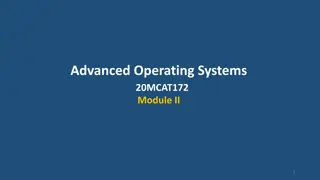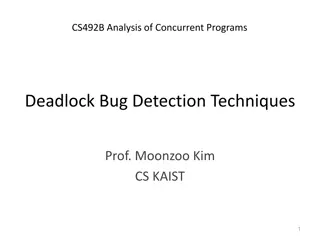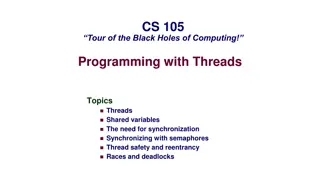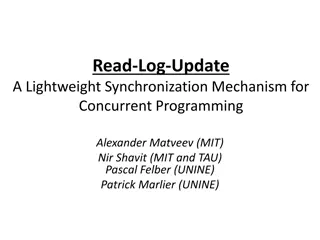Understanding and Avoiding Deadlocks and Livelocks in Concurrent Programming
Deadlocks and livelocks are common issues in multi-threaded programming. Deadlocks occur when two or more threads are waiting for each other to release a resource, leading to a standstill. Livelocks, on the other hand, involve threads that are actively trying to resolve a resource conflict but end up in a loop without making progress. Understanding these concurrency problems is crucial for designing robust systems. Various examples illustrate scenarios that can lead to deadlocks and strategies to prevent them, like using mutex objects, atomic data types, monitor patterns, lightweight vs. heavyweight threads, and recursive mutexes in C++.
Download Presentation

Please find below an Image/Link to download the presentation.
The content on the website is provided AS IS for your information and personal use only. It may not be sold, licensed, or shared on other websites without obtaining consent from the author. Download presentation by click this link. If you encounter any issues during the download, it is possible that the publisher has removed the file from their server.
E N D
Presentation Transcript
DEADLOCKS, LIVELOCKS, AND HOW TO Professor Ken Birman CS4414 Lecture 17 AVOID THEM CORNELL CS4414 - SPRING 2023 1
IDEA MAP FOR TODAYS LECTURE The monitor pattern in C++ Reminder: Thread Concept Problems monitors solve (and problems they don t solve) Lightweight vs. Heavyweight Thread context Deadlocks and Livelocks C++ mutex objects. Atomic data types. Today we focus on deadlocks and livelocks. CORNELL CS4414 - SPRING 2023 2
DEADLOCK: UNDERSTANDING Deadlock arises in situations where we have multiple threads that share some form of protected object or objects. For simplicity, A and B share X and Y. Now suppose that A is holding a lock on X, and B has a lock on Y. A tries to lock Y, and B tries to lock X. Both wait, forever! CORNELL CS4414 - SPRING 2023 3
MORE EXAMPLES We only have one object, X. A locks X, but due to a caught exception, exits the lock scope. Because A didn t use scoped_lock, the lock isn t released. Now B tries to lock X and waits. Because A no longer realizes it holds the lock, this will persist forever. CORNELL CS4414 - SPRING 2023 4
MORE EXAMPLES We only have some critical section A locks it, but now needs to wait for some condition. The developer didn t use the monitor pattern, and instead drops the lock and then waits on some other form of mutex But B ran as soon as the lock was released, and by the time A waits, the condition A was waiting for is already true. CORNELL CS4414 - SPRING 2023 5
ACQUIRING A MUTEX TWICE Suppose that A is in a recursive algorithm, and the same thread attempts to lock mutex X more than once. The recursion would also unlock it the same number of times. This is possible with a C++ recursive_mutex object. But the standard C++ mutex is not recursive. CORNELL CS4414 - SPRING 2023 6
WHAT IF YOU TRY TO RECURSIVELY LOCK A NON-RECURSIVE MUTEX? The resulting behavior is not defined. On some platforms, this will deadlock silently. A waits for A! On others, you get an exception, Deadlock would result. CORNELL CS4414 - SPRING 2023 7
MORE EXAMPLES A and B lock X and Y. The developer noticed the deadlock pattern but did not understand the issue. C++ lock primitives have optional timeout arguments. So the developer decided to add a random backoff feature: When locking an object, wait t milliseconds. Initially, t=0 but after a timeout, change to a random value [0..999] Then retry CORNELL CS4414 - SPRING 2023 8
WHAT DOES THIS GIVE US? Now A locks X (and holds the lock), and B locks Y A tries to lock Y, times out, retries forever B tries to lock X, times out, retries forever They aren t waiting yet they actually are waiting! CORNELL CS4414 - SPRING 2023 9
DEADLOCK AND LIVELOCK DEFINITIONS We say that a system is in a deadlocked state if one or more threads will wait indefinitely (for a lock that should have been released). Non-example: A is waiting for input from the console. But Alice doesn t type anything. Non-example:A lock is used to signal a cupcake is ready , but we have run out of sugar and none can be baked. CORNELL CS4414 - SPRING 2023 10
NECESSARY AND SUFFICIENT CONDITIONS FOR DEADLOCK 1. Mutual exclusion: The system has resources protected by locks 2. Non-shareable resources: while A holds the lock, B waits. 3. No preemption: there is no way for B to seize the lock from A. 4. Cyclic waiting: A waits for B, B waits for A (a circular pattern) With recursion using non-recursive locks, A could deadlock by itself CORNELL CS4414 - SPRING 2023 11
CONDITIONS FOR LIVELOCK A livelock is really the same as a deadlock, except that the threads or processes have some way to spin . As a result, instead of pausing, one or more may be spin-waiting. We can define inability to enter the critical section as a wait, in which case the four necessary and sufficient conditions apply. CORNELL CS4414 - SPRING 2023 12
C++ AND LINUX ARE FULL OF RISKS! If you think about it, you can find hundreds of ways that Linux could potentially be at risk of deadlocks! If you code with threads in C++ you run that risk too! The developers of Linux designed the system to be free of deadlock. You can do so in your applications too. But it takes conscious though and a careful design. CORNELL CS4414 - SPRING 2023 13
HOW TO AVOID DEADLOCKS? Acquire locks in a fixed order that every thread respects. This rule implies that condition 4 (cyclic waiting) cannot arise. Example: Recall A and B with X and Y. Use alphabetic ordering We had A holding a lock on X and requesting a lock on Y: if our rule says lock X before Y, this is legal and A must wait. Meanwhile B held a lock on Y. Given our rule, B is not allowed to request a lock on X at this point. CORNELL CS4414 - SPRING 2023 14
AS A TIMELINE PICTURE A: lock X B: lock Z A: lock Y A: lock Z B: lock X B isn t permitted to lock X under an ordered locking rule. X is alphabetically smaller than Z, and B locked Z earlier CORNELL CS4414 - SPRING 2023 15
THIS RULE CAN BE IMPRACTICAL There are many applications that learn what they must lock one item at a time, in some order they cannot predict. So in such a situation, B didn t know it would need a lock on X at the time it locked Z. now it is too late! CORNELL CS4414 - SPRING 2023 16
EXAMPLE: UNPREDICTABLE LOCK ORDER For example, this could arise in a for loop. Maybe B is scanning a std::list<Animal*>, and needs a lock on each Animal. Fuzzy Tribble Darwin s Tortle Policle The std::list isn t sorted by Animal.name. The lock rule requires locks in Animal-name sort order. B locks Fuzzy Tribble and Policle but now can t lock Ballard s Hooting Crane CORNELL CS4414 - SPRING 2023 17
WHAT IF IT TRIES? This is a rule you would impose on yourself If you don t respect your own design, that would be a bug in your code. C++ itself won t enforce this rule. It definitely is possible to wrap locks in a way that would track locking and detect cyclic wait, but this isn t standard in C++ CORNELL CS4414 - SPRING 2023 18
EVEN SO, ORDERED LOCKING IS USEFUL When you actually can impose an order and respect the rule, it is a very simple and convenient way to avoid deadlock. Ordered locking is very common inside the Linux kernel. It has a cost (an application may need to sort a list of items, for example, before locking all of them), but when feasible, it works. CORNELL CS4414 - SPRING 2023 19
TIMER BASED SOLUTIONS Sometimes it is too complicated to implement orderd locking. So we just employ a timeout. If B is running and tries to get a lock, but a timeout occurs, B aborts (releasing all its locks) and restarts. CORNELL CS4414 - SPRING 2023 20
BACKING OUT AND RETRYING For this purpose, B would employ try_lock . Backout can be costly This is a feature that acquires a lock if possible within some amount of time, but then gives up. If B gets lucky, it is able to lock Y, then X, and no deadlock arises. But if the lock on Y fails, B must unlock X. CORNELL CS4414 - SPRING 2023 21
CONCEPT: ABORT AND RETRY We say that a computation has aborted if it has a way to undo some of the work it has done. For example, B could be executing, lock Y, then attempt to lock X. The try_lock fails, so B releases the lock on X and throws away the temporary data it created it rolls back . Then it can retry, but get a lock on X first. Hopefully this will succeed. CORNELL CS4414 - SPRING 2023 22
DOES THIS WORK? Many database systems use abort/retry this way. If deadlocks are very rare, the odds are that on retry, B will be successful. But if deadlocks become common, we end up with a livelock. CORNELL CS4414 - SPRING 2023 23
PREEMPTIVE SOLUTION (WOUND-WAIT) This method requires some way for the system to detect a deadlock if one arises, and a way for threads to abort. When A and B start executing, each notes its start time. Rule: in a deadlock, the older thread wins. So if A was first, A gets to lock Y and B aborts. If B was older, A aborts. CORNELL CS4414 - SPRING 2023 24
DETECTING DEADLOCKS Clearly, we gain many options if a system has a way to detect deadlocks. Does C++ support this? you might think so, given the deadlock would arise exception for recursive locking. But in fact this is done just by tracking the thread-id for the thread holding a mutex. CORNELL CS4414 - SPRING 2023 25
HOW TO BUILD A DEADLOCK DETECTOR We wrap every locking operation with a method that builds a graph of which thread is waiting for which other thread. For example, if A tries to lock Y, but B is holding that lock, we add a node for A, a node for B, and an A edge. If a thread is waiting for long enough, run cycle detection . CORNELL CS4414 - SPRING 2023 26
CYCLE DETECTION ALGORITHMS A B Run the depth-first search algorithm. Back-edges imply a cycle; success with no back-edges implies that the graph is cycle-free, hence there is no deadlock. Complexity: V+E, where V is the number of threads (nodes) and E is the number of wait-edges. CORNELL CS4414 - SPRING 2023 27
PRIORITY INVERSIONS In some systems, threads are given different priorities to run. Urgent: The thread should be scheduled as soon as possible. Normal: The usual scheduling policy is fine. Low: Schedule only when there is nothing else that needs to run. A priority inversion occurs if a higher priority thread is waiting for a lower priority thread. Deadlock can now arise if there is a steady workload of high priority tasks, so that the lower priority thread doesn t get a chance to run. CORNELL CS4414 - SPRING 2023 28
HOW TO DETECT THIS SORT OF PROBLEM If we create a deadlock detector, we can extend it do handle priority-inversion detection! For each mutex, track the priority of any thread that accesses it. If we ever see a mutex that is accessed by a high and a low priority thread, a risk of priority inversion arises! CORNELL CS4414 - SPRING 2023 29
WHAT TO DO ABOUT IT? One option is to temporarily change the priority of the lower priority thread. Suppose that A holds a mutex on X. B, higher priority than A, wants a lock on X. We can bump A to higher priority temporarily, then restore A to lower priority when it releases the lock on X. CORNELL CS4414 - SPRING 2023 30
NONE OF THESE IS CHEAP Recall our discussion of C++ versus Java and Python. These methods of watching for cycles or priority inversions, possibly forcing threads to abort, rollback and retry, etc, are all examples of runtime mechanisms that can be very costly! If you have no choice, then you use them. But don t be na ve about how expensive they can become! CORNELL CS4414 - SPRING 2023 31
JIM GRAY Jim Gray, a Turing Award winner, was a big player in inventing databases and transactions . He worked at Microsoft Jim s focus for much of his career was on making it easier to create really big databases and to access them from programming languages like C++ (or C#, Java, Python, whatever) CORNELL CS4414 - SPRING 2023 32
JIM GRAYS STUDY In the 1990 s, databases were used for storing all forms of data By the early 2000 s, they became extremely big and heavily loaded. People began to move them to NUMA machines and to use lots of threads. Surprisingly, they slowed down! CORNELL CS4414 - SPRING 2023 33
JIM TRACKED DOWN THE CAUSE It turned out that with more and more load on the database server, hence lots of threads, the database locking algorithm was discovering a lot of deadlocks. Running the cycle detector, aborting all of those waiting threads, rolling back and then retrying it all added up to huge overheads! Jim showed that once this occurred, his databases slowed down CORNELL CS4414 - SPRING 2023 34
THE FULL STORY He found that if you have a system with n servers (or using n cores), and the system is trying to process t simultaneous transactions (transactions), it could slow down as You used cores or servers to have your system handle more concurrent threads or transactions O( n3 t5 ) but it slows down, dramatically! CORNELL CS4414 - SPRING 2023 35
SIDEBAR Jim didn t specifically think about n being cores, and t perhaps being threads that access shared variables and locks. But this is a reasonable generalization and in fact holds, if the threads exhibit a pattern of synchronization similar to the one he examined in his famous paper, where a transaction touches variables randomly, using an i.i.d. access pattern. CORNELL CS4414 - SPRING 2023 36
NOT WHAT WE WANTED! People who buy a NUMA machine and run a program with more threads want more performance, not less! Also, the situation Jim identified didn t arise instantly. It only showed up under heavy load. This made it hard to debug A Heisen-performance-bug! Very bad news Hard to find, impossible to fix! CORNELL CS4414 - SPRING 2023 37
WHAT DID JIM RECOMMEND? He found ways to slice his big data sets into n distinct, independent chunks. He called this sharding. Then he put each shard each chunk of data into its own database. He ran the n databases separately! like when fast-wc had a separate std::map for each thread. CORNELL CS4414 - SPRING 2023 38
TRUE THOUGHT PROBLEM Ken was on sabbatical in Paris in 1995-1996 There are two traffic circles in France in which priority favors allowing cars to enter the circle over exit. Deadlock occurs! Would priority to the left have the same risk? CORNELL CS4414 - SPRING 2023 39
VISUALIZING THE PRIORITE-A-DROITE CYCLE Many streets. Traffic flows in counter-clockwise direction Streets are mostly two-way Core problem: some cars just want to leave, but others continue around. But any entering car gets to go first CORNELL CS4414 - SPRING 2023 40
PRIORITY TO THE LEFT IS THE MODERN RULE Most of the drives on the right hand side world uses the priority-to-the-left rule. For a traffic circle, this means cars in the circle have priority over cars wanting to enter. Drains traffic out. But these two traffic circles, and also the whole country of Belgium, use priorite-a-droite and deadlock. CORNELL CS4414 - SPRING 2023 41
SUMMARY Deadlock is a risk when we have concurrent tasks (threads or processes) that share resources and use locking. There are simple ways to avoid deadlock, but they aren t always practical. Ordered locking is a great choice, if feasible. Complex options exist, but they can have high overheads. CORNELL CS4414 - SPRING 2023 42
SUMMARY Livelock is a form of deadlock in which threads or processes are active but no progress is occurring. Often associated with some form of busy wait loop. Deadlock avoidance mechanisms often can prevent livelocks, too CORNELL CS4414 - SPRING 2023 43























